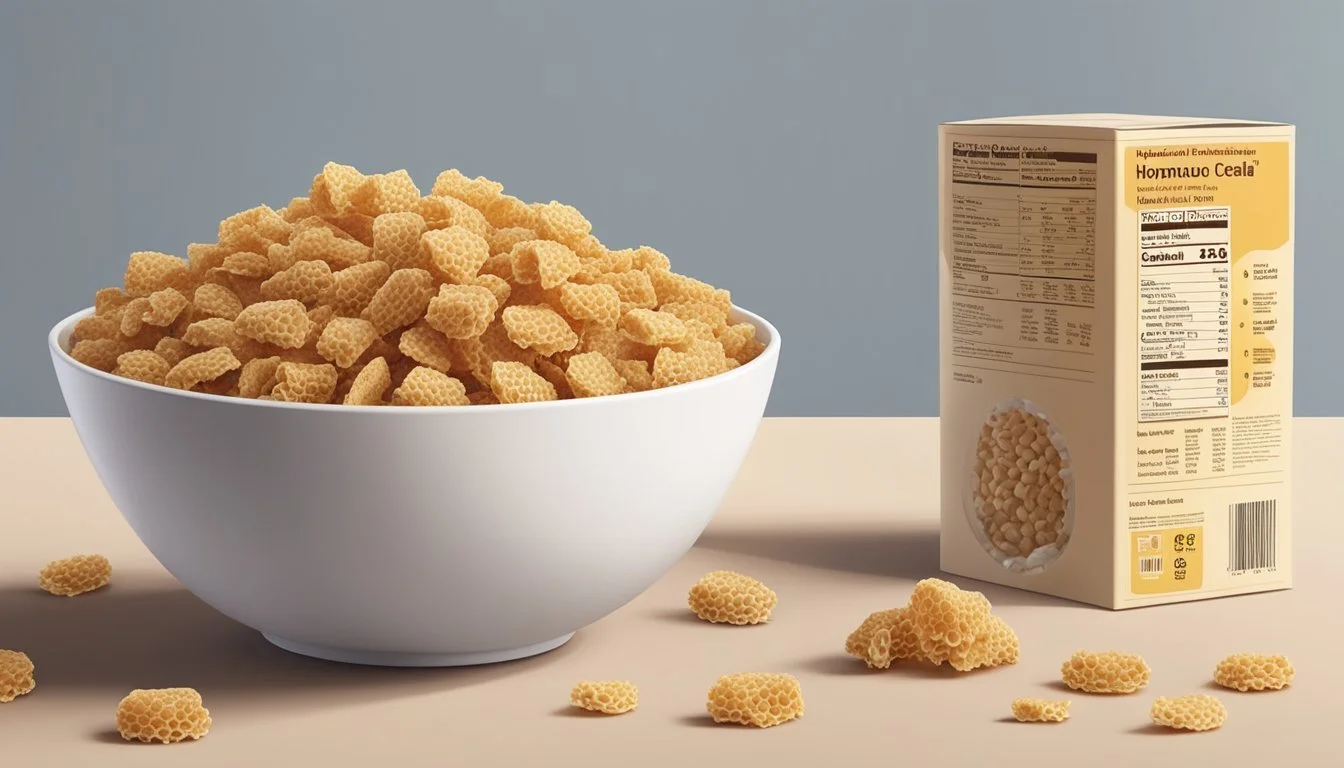All-Bran vs Honeycomb
Which Cereal is Healthier?
This Article is Part of Our Breakfast Cereal Guide with Details on All-Bran Nutrition and Honeycomb Nutrition
Starting the day with a nutritious breakfast sets the tone for the rest of the day. When comparing All-Bran and Honeycomb cereals, one could wonder which is the healthier option. All-Bran cereal offers a significantly higher amount of fiber, providing 29.3 grams per serving compared to Honeycomb's 3.2 grams.
Nutritional content varies between the two, with All-Bran being richer in essential vitamins and minerals like Vitamin B6, Vitamin B12, and Iron. Meanwhile, Honeycomb boasts higher amounts of specific vitamins such as Vitamin B12 and Vitamin D. For those looking to boost their fiber intake and receive a broad spectrum of nutrients, All-Bran appears to be a stronger choice.
Despite these differences, personal preference and dietary needs will play a crucial role in deciding between these two cereals. The information presented aims to clarify the nutritional comparison, helping readers make an informed decision suitable for their healthy breakfast routine.
Cereal Overview
All-Bran and Honeycomb are two breakfast cereals with distinct nutritional profiles and histories. Both cereals originated from well-known brands, Kellogg's and Post, and have been popular choices among consumers for many years.
History of All-Bran
All-Bran, produced by Kellogg's, was introduced in 1916. It was created as part of a health-focused marketing strategy emphasizing the benefits of fiber. All-Bran became notable for being high in dietary fiber, primarily wheat bran, which aids in digestion and promotes overall health.
The cereal was part of Kellogg's efforts to address nutritional deficiencies and was marketed to health-conscious consumers. Over the years, Kellogg's continually updated the product to meet new dietary trends and consumer preferences, maintaining its status as a staple in healthy breakfast choices.
History of Honeycomb
Honeycomb, made by Post, debuted in 1965. It was designed to appeal to children with its unique honeycomb-shaped pieces and sweet honey flavor. Unlike All-Bran, Honeycomb focused less on fiber and more on taste and texture, ensuring it was enjoyable as well as nutritious.
The cereal quickly became a favorite among kids and remains a nostalgic choice for many adults. Post has maintained the original flavor profile while occasionally releasing limited-edition variations to keep the product line fresh and exciting.
Producing a striking contrast to All-Bran, Honeycomb's history reflects its emphasis on the enjoyment factor in breakfast cereals, a strategy that has helped Post maintain a dedicated customer base.
Nutritional Profiles
All-Bran and Honeycomb cereals offer diverse nutritional benefits. Focusing on specific aspects like macronutrients and micronutrients helps to understand their dietary contributions more clearly.
Macronutrients in All-Bran
All-Bran is rich in fiber, making it an excellent choice for digestive health. With approximately 29.3 grams of fiber per serving, it surpasses many other cereals. All-Bran provides around 70 calories per serving, which is relatively low, aiding in weight management.
The protein content stands at 3 grams per serving, making it a modest source of protein. Carbohydrates, largely composed of fiber, total approximately 23 grams. There is minimal fat content in All-Bran, with less than 1 gram of fat per serving, none of which is saturated fat.
Micronutrients in All-Bran
All-Bran excels in its micronutrient profile. It contains significant amounts of Vitamin B6, meeting 803% of the daily need. The cereal is also rich in Vitamin B12, Folate, Phosphorus, Iron, and Magnesium.
It provides Vitamin B2, as well as Copper and Vitamin B1, enhancing energy metabolism and supporting nerve function. These micronutrients contribute to the overall health benefits, making All-Bran a nutrient-dense option.
Macronutrients in Honeycomb
Honeycomb cereal, in contrast, has a different nutritional focus. Each serving contains around 3.2 grams of fiber, which is significantly less than All-Bran. Honeycomb has a higher caloric content, around 113 calories per serving, primarily due to its sugar content.
Protein in Honeycomb is relatively low, with 1.5 grams per serving. The carbohydrate content is higher, with approximately 24 grams per serving, partly from added sugars. Fat content remains low at around 0.5 grams, none of which is saturated fat.
Micronutrients in Honeycomb
Honeycomb cereal also contains essential vitamins and minerals, though to a lesser extent. It offers Vitamin B12, covering 90% of daily needs, and Vitamin C. Honeycomb contains trace amounts of Iron and Copper but significantly less compared to All-Bran.
It has lower levels of Vitamin B6 and does not provide as many whole grains or fiber. The focus is more on energy-providing nutrients with added sugars and essential vitamins to complement basic dietary needs.
Health Impacts
All-Bran and Honeycomb differ significantly in their nutritional profiles, particularly in dietary fiber and sugar content. These differences affect digestive health, blood sugar levels, and weight management.
Dietary Fiber Benefits
All-Bran contains 9 grams of dietary fiber per serving. Both soluble and insoluble fibers contribute to its health benefits. Soluble fiber helps lower LDL cholesterol and stabilizes blood sugar levels.
Insoluble fiber aids in reducing constipation and promoting regular bowel movements. Increased fiber intake from All-Bran can help improve overall digestive health and reduce the risk of chronic conditions such as heart disease and certain cancers.
Honeycomb, on the other hand, has just 0-3.2 grams of fiber per serving, offering minimal benefits in this area.
Sugar and Health Concerns
All-Bran has 5-12 grams of sugar per serving. While it contains some added sugars like brown sugar syrup, its low sugar content compared to Honeycomb makes it a healthier choice for those monitoring blood sugar levels.
Honeycomb contains 11 grams of sugar per serving. High sugar content can lead to several health issues, including weight gain, increased risk of obesity, and poor blood sugar control.
Consumers aiming to reduce sugar intake and manage diabetes should prefer All-Bran over Honeycomb.
Weight Management
High-fiber foods like All-Bran are beneficial for weight loss and management. Fiber-rich foods help keep you full longer, reducing overall calorie intake.
All-Bran's high fiber content can aid in maintaining a healthy weight by promoting satiety and reducing overeating.
In contrast, Honeycomb's high sugar content and low fiber provide little support in weight management and may contribute to weight gain.
Choosing All-Bran over Honeycomb could be a strategy for those focusing on achieving or maintaining a healthy weight.
Consumer Considerations
Choosing between All-Bran and Honeycomb cereals involves evaluating factors like taste, texture, price, and overall value for money. These considerations can significantly influence a consumer's decision based on specific dietary needs and preferences.
Taste and Texture Comparison
All-Bran has a distinctive, mildly sweet flavor with a slightly gritty texture. This cereal is denser and has a chewiness that some consumers appreciate for its heartier mouthfeel.
Honeycomb, on the other hand, is known for its light, airy texture and pronounced sweet taste. The cereal pieces are larger, making them crunchier and less dense than All-Bran. Flavor and texture are subjective, and preferences can vary widely, but these differences are key for consumers to note when deciding between the two.
Price and Value
When comparing price, All-Bran tends to be moderately priced, reflecting its high fiber content and nutritional benefits. Consumers looking for an economical option that also provides significant nutritional value might find All-Bran to be a cost-effective choice.
Honeycomb, while sometimes priced similarly to All-Bran, often appeals to those seeking a sweeter cereal experience. Considering the value for money, Honeycomb might not offer the same level of dietary fiber and other nutrients as All-Bran. Shoppers must weigh the price against the nutritional benefits and decide which factors matter most in their purchasing decision.
Dietary Preferences and Restrictions
The nutritional composition of All-Bran and Honeycomb influences their suitability for various dietary needs, including gluten sensitivity and vegan preferences.
Gluten and Allergen Information
All-Bran contains wheat bran, making it unsuitable for those with celiac disease or gluten intolerance. Additionally, it may contain traces of other allergens like soy or nuts due to cross-contamination during manufacturing.
Honeycomb Cereal is also not gluten-free, as it contains ingredients derived from wheat. It is important to check for allergen information on the packaging, especially for common allergens such as soy and nuts, to ensure it meets specific dietary requirements.
Suitability for Restricted Diets
Vegetarian: Both cereals are suitable for a vegetarian diet as they do not contain meat or meat-derived ingredients.
Vegan: All-Bran may not be fully vegan due to added vitamin D3, often derived from lanolin in sheep's wool. Honeycomb might also contain such additives, so careful inspection is needed.
Dairy-Free: Both cereals do not inherently contain dairy, making them suitable for dairy-free diets. However, check for potential cross-contamination warnings.
Nut-Free: Neither cereal lists nuts as primary ingredients, but production practices can vary. Always check labels for potential contamination.
Selecting a cereal suitable for your dietary needs requires careful consideration of these factors and consultation of ingredient lists and nutrition labels.







